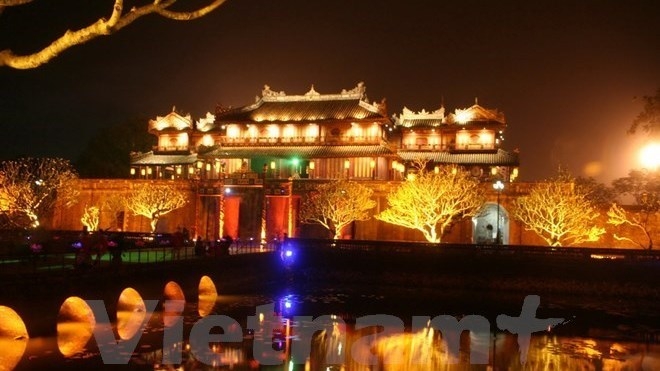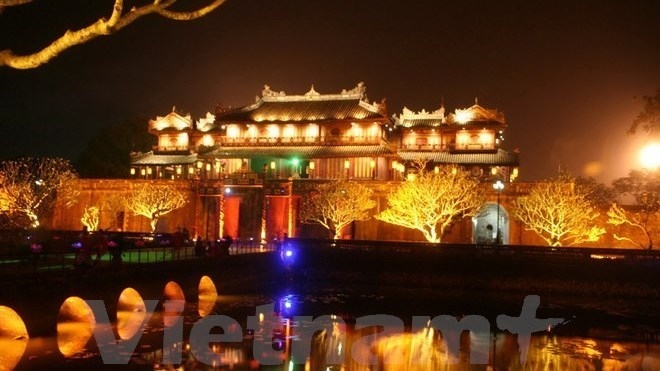
The flow of foreign tourists into the central province of Thua Thien-Hue increased by 31.29 percent to 1.07 million in the first nine months of 2017.

Hue imperial city by night
(Photo: VNA)
The
Republic of Korea ranked first in terms of the number of holidaymakers visiting
Thua Thien-Hue, making up 26 percent of the total number.
In the
reviewed period, the province served a total of 2.78 million visitors. The Hue
Relics Preservation Centre alone welcomed 2.4 million visitors, up 18.55 percent
from the same period last year.
In
September 2017, the provincial Department of Tourism and Traveloka Vietnam
Company signed a Memorandum of Understanding on tourism development, which aims
to connect accommodation establishments, airlines and potential customers.
The
locality also signed a cooperation agreement with the national flag carrier
Vietnam Airlines to promote Hue at domestic and foreign tourism trade fairs, in
addition to increasing flights and launching new routes to the imperial city.
In 2017,
Thua Thien-Hue province expects to attract over 3 million tourists, of which
international visitors will make up 40-45 percent, raking in more than VND3
trillion (US$131 million).
Hue, which
was the imperial capital of Vietnam for hundreds of years, is home to five
heritages recognised by UNESCO, which are the Hue ancient citadel relic complex
- a World Cultural Heritage site; Nha Nhac (Hue royal court music) - an
intangible cultural heritage item; Nguyen Dynasty’s wood blocks - a documentary
heritage item; Nguyen Dynasty’s Chau ban (royal administrative documents) -
part of the Asia-Pacific Register of UNESCO’s Memory of the World Programme;
and literature on Hue royal architecture - a documentary heritage.
The Hue
imperial citadel relic ranked second among the top seven tourism attractions of
Vietnam in 2017.
Source: NDO
Spanning thousands of hectares and winding gracefully along mountain slopes, hillsides, and riverbanks, the terraced rice fields of Lac Son District present a stunning and captivating beauty. This region, renowned for its remarkable terraced landscapes, is also the centre of Hoa Binh Culture known for numerous archaeological sites.
The life of Mong people in Hang Kia and Pa Co communes of Mai Chau district has improved much thanks to tourism development.
The man-made Hoa Binh Lake, with a water surface area of approximately 9,000 hectares and a capacity of 9.45 billion cubic meters, stretches over 200 kilometers from Hoa Binh to Son La provinces. With the goal of developing into a national tourism area, the Hoa Binh Lake tourism area is expected to not only become the largest tourism centre in the province but also one of the 12 key tourist destinations in the northern midland and mountainous region of Vietnam.
Da Bia hamlet, now Duc Phong, in Tien Phong commune, Da Bac district, was once almost isolated from the outside as the only way to the hamlet was to get a boat ride across the Hoa Binh reservoir. However, as its tourism potential has been unleashed, the hamlet has established itself as one of the most attractive destinations on the tourism map. It has even received the ASEAN Community-Based Tourism Awards in 2019.
In the first 9 months of 2024, Mai Chau district, Hoa Binh province welcomed over 684 thousand visitors to visit and relax. In which, over 516 thousand domestic visitors and more than 168 thousand international visitors. Total revenue from tourism is estimated at over 821 billion VND.
Da Bac district, bestowed with stunning landscapes, is developing ecological and resort tourism offerings. Several tourist sites, put into operation this year, has attracted throngs of high-spending and young domestic visitors.



